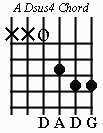| E | A | D | G | B | E |
| | | | 1 | | |
| 1 | 1 | 1 | 2 | 1 | 1 |
| | | | | 2 | |
| 3 | 3 | 3 | 4 | | |
| 4 | 4 | | | 4 | |
Tuesday, September 25, 2007
D G B E
_ _ _ 1
_ 2 _ _
_ _ 3 _
New D Minor Pattern
D G B E
_ _ _ 1
_ 2 _ _
3 _ 4 _
The difference being the addition of an extra, “bassy” F note using the 3rd finger. Note that On the 4th string, 3rd fret, the note is an F. So we are still playing the same chord with a “bassy” feel.
This pattern is useful because it’s a movable chord and can be used to play different minor chords lower down on the fretboard.
Suspension Chords
For e.g.
Suspension 2 means using the 1st, 2nd and 5th notes from a major scale.
So from Sa-Ga-Pa we go to Sa-Re-Pa.
So from Sa-Ga-Pa we go to Sa-Ma-Pa.
Chord to Hold String to play
D-sus-2 1, 2, 3
D 1, 2, 3
D-sus-4 1, 2, 3
D 1, 2, 3
D-sus-2 1, 3
D 1, 3
A 2, 3, 4
A-sus-2 2, 3, 4
A 2, 3, 4
A-sus-4 2, 3, 4
A 2, 3, 4
A-sus-2 2, 4
A 2, 4
Chords:
Bm – A – D – G
F – A# - C
| 1 | A | & | E | 2 | A | & | E | 3 | A | & | E | 4 | A | & | E |
| D | M | | D | M | M | M | M | M | D | M | M | M | M | M | M |
M - Mute
Wednesday, September 19, 2007

As another example, an Asus4 chord (formed x02230) is made up of A, D, and E, as shown here:

Once you understand this, the following fingerings of common sus4 chords becomes apparent:
Bsus4 Dsus4 Esus4 F#sus4 Gsus4 | dansm rules | x02230 x24452 xx0233 022200 244422 3x0013 |
Once you understand the theory behind sus4 chords, sus2 chords are very similar. Instead of the root, fourth, and fifth in a sus4 chord, a sus2 chord contains the root, second, and fifth. Sus2 chords have the pattern 1-2-5. Therefore, a Dsus2 will contain D, E, and A, giving a fingering which looks like this:

As another example, an Asus2 chord (formed x02200) is made up of A, B, and E, as shown here:

Once you understand this, the following fingerings of common sus2 chords becomes apparent:
Bsus2 Dsus2 | dansm rules | x02200 x24422 xx0230 |
That's about it with suspended chords. They are really easy to understand once you understand a little bit of theory. Also, I haven't notated many barre chords above because I assume that once you know a Bsus2 or Bsus4 you can figure out how to make a Csus4. Have fun with these, and be happy that the next time you see sus4 you will understand!

